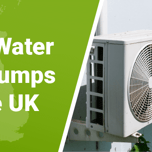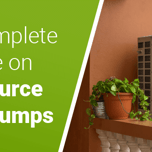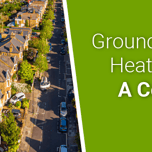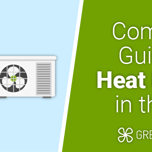Answer these simple questions and we will find you the BEST prices
Which type of solar quotes do you need?
It only takes 30 seconds
100% free with no obligation

Get up to 4 quotes by filling in only 1 quick form

Install a heat pump for less with the BUS grant

We’ve helped over 500,000 homeowners reduce their carbon footprint
- GreenMatch
- Air Source Heat Pumps
- Air to Air Heat Pumps
Air to Air Heat Pumps in the UK: Costs, Installation, Pros & Cons

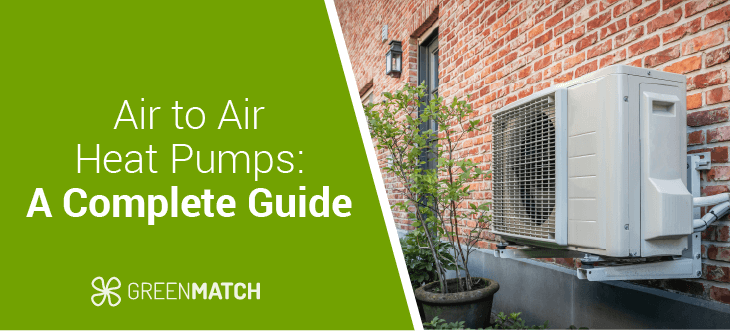
- Air to air heat pumps deliver efficient heating in winter and cooling in summer, lowering energy bills while keeping your home comfortable year-round.
- Air-to-air heat pumps can reduce annual heating costs by £290 compared to G-rated gas boilers and up to £1,200 compared to electric storage heaters.
- On average, an air to air source heat pump costs about £4,000 – £9,500.
Looking to save energy with an air to air heat pump? You’re in the right place. In this article, we’ll discuss the average air to air heat pump cost in the UK, government incentives, and the pros and cons of this heating system.
Interested in air to air heat pumps? We can help you get the best deal! Don’t waste hours contacting installers on your own. Simply fill out our 30-second form, and we’ll do the rest. We’ll connect you with up to 4 trusted installers near you for free, no-obligation quotes.
- Quotes from local engineers
- Payment by finance available
- Save £7,500 with BUS grant
It only takes 30 seconds



What is an air to air heat pump?
An air to air heat pump is a type of heating and cooling system that transfers heat from the outside air into your home to provide warmth during colder months. In the summer, many models can reverse the process to cool your home by removing heat from inside. They do this either from a single outdoor unit, known as a monobloc heat pump, or a split indoor and outdoor unit.
How does an air to air heat pump work?
Air to air heat pumps take heat from the outside air—even when it’s cold—and transfer it indoors to warm your home. They use a system of fans and refrigerant to absorb heat outside and release it inside, making them an efficient way to heat a building. Air source heat pumps for flats work in the same way, making them a great option for smaller spaces.
The process by which an air to air source heat pump heats your home can be summed up in these steps:
- The air to air heat pump pulls in air from outside.
- The heat is absorbed into a special liquid (called a refrigerant).
- This liquid turns into a gas and is compressed to make it hotter.
- The hot gas travels to the indoor unit, where it releases the heat to warm your rooms.
- As the gas cools, it turns back into a liquid and starts the cycle again by returning to the outdoor unit.
If you’d like to replace a gas boiler with a heat pump, an air to air heat pump is a cost-effective alternative that can significantly lower your energy bills.
You can also combine an air source heat pump and a gas boiler for domestic hot water purposes using a hybrid heat pump system. A high temperature heat pump will also ensure that you can achieve consistently high levels of heating and hot water.
Air to air heat pump cost in the UK
Air to air heat pumps are among the most affordable heat pumps in the UK market, with the average air to air heat pump price ranging from £4,000 to £9,500. Moreover, current air to air heat pump installation costs in the UK range from £350 to £1,700 and will differ depending on the complexity of the installation.
Running costs will vary based on factors like household size and energy needs, with annual estimates of £900 for a one-bedroom home, £1,200 for two bedrooms, and £1,700 for three bedrooms.
These costs are also affected by the heat pump's efficiency. Heat pump efficiency is measured by the Coefficient of Performance (CoP), which tells you how much heat it produces compared to the electricity it uses.
For example, a CoP of 3 means the pump produces 3 times more heat than the electricity it uses, making it much more efficient than traditional heating systems.
If your heat pump has a high CoP, it will cost less to run even if you live in a larger home since it uses electricity more efficiently. On the other hand, if you have a lower CoP heat pump, your running costs will be higher, especially if you have a bigger home that requires more heating.
Heat pumps with higher CoP usually cost more upfront because they are designed with advanced technology to achieve greater efficiency. However, this initial investment often pays off in the long term through lower running costs.
The total cost for air to air heat pump installation and operation will be affected by factors such as home size, energy consumption, and proper system sizing.
As a general rule of thumb, you can find out the right air to air heat pump size for you by calculating around 5kW worth of energy output per 100m² of space.
Below, you can find the estimated cost of an air to air heat pump per household size:
| Household Size | Average Energy/Gas Consumption (kWh) | Estimated Installation Cost | Estimated Annual Running Cost |
|---|---|---|---|
| 1 bedroom | 1,800/8,000 | £4,000 | £990 |
| 2 bedrooms | 2,500/10,000 | £4,000 | £1,410 |
| 3 bedrooms | 3,000/12,000 | £7,000 | £2,000 |
| 4+ bedrooms | 3,500/15,000 | £9,500 | £2,200+ |
Remember that these numbers are rough estimates, and a personalised calculation is highly advisable. Seek professional advice to get a clearer picture of how much running an air to air heat pump at your property will cost you.
Comparing heat pump installers can take hours and be very stressful when done alone. Fortunately, we can connect you with up to 4 approved installers near you for free!
Just fill in our 30-second form, and we’ll do the rest.
Click below to begin!
- Quotes from local engineers
- Payment by finance available
- Save £7,500 with BUS grant
It only takes 30 seconds



Air to air heat pump savings
To help you see the potential savings, we’ve compared air source heat pumps with traditional heating systems. Here's what we found:
| Current Heating System | Estimated Annual Savings |
|---|---|
| New (A-rated) gas boiler | -£3 |
| Old (G-rated) gas boiler | £290 |
| Old electric storage heaters | £1,200 |
| New electric storage heaters | £700 |
| Old (G-rated) oil boiler | £280 |
| New (A-rated) oil boiler | -£55 |
| Old (G-rated) LPG boiler | £650 |
| New (A-rated) LPG boiler | £260 |
| Coal | £650 |
For further insights, we recommend reading our article on the differences between a gas boiler vs a heat pump.
Air to air heat pump grants
Nevertheless, despite the savings, installing an air to air heat pump is still a significant investment. To lessen the financial burden of installing this energy source, you can apply for one of the heat pump grants available in the UK.
One such incentive is the Boiler Upgrade Scheme (BUS), with which you can receive up to £7,500 to assist with your air source heat pump costs.
| Grant Name | Coverage Area | Savings | Details |
|---|---|---|---|
| Boiler Upgrade Scheme | England and Wales | £7,500 | For air or ground source heat pumps, including high temperature heat pumps |
| Energy Company Obligation Scheme (ECO4) | England, Scotland and Wales | Varies | Financial assistance for low-income households to install energy-efficient systems |
| 0% VAT | UK-wide | Up to £750 | VAT reduction on clean energy solutions, including heat pump installations, until 2027 |
| Warmer Homes Scotland | Scotland | £10,000 | Interest-free loan for installing energy-efficient systems |
| Home Energy Scotland Scheme | Scotland | £15,000 | Interest-free loan for installing renewable energy sources |
| Nest Scheme | Wales | Full cost | Covers all costs of air source heat pump installation for eligible households |
Many grants are region-specific. Our guide on air to air heat pumps can give you a good overview, but we also have resources dedicated to heat pumps in Wales, heat pumps in Scotland and heat pumps in Northern Ireland.
To be eligible for the Boiler Upgrade Scheme, you need to meet the following criteria:
- You are a homeowner, small landlord, or private landlord in England or Wales.
- You have a valid Energy Performance Certificate (EPC) with no outstanding loft or cavity wall insulation recommendations.
- You are not replacing an existing low-carbon heating system; you can only replace fossil fuel heating systems (e.g., oil, gas, direct electric).
- You have an air to air heat pump installation capacity up to 45kWth (kilowatt thermal capacity).
Want to know more about the cost of installing an air to air heat pump or how to benefit from a heat pump grant? Talk to air source heat pump installers near you who can offer you tailored advice. Instead of wasting hours on tedious research, let us connect you with installers from our network in no time.
Fill out our quick 30-second form to get quotes from up to 4 local air to air heat pump installers. Compare their offers to find the best installer and deal for your new heat pump. Click below to request free, no-obligation quotes today!
- Quotes from local engineers
- Payment by finance available
- Save £7,500 with BUS grant
It only takes 30 seconds



Air to air heat pump installation process
The installation process of an air to air heat pump is simple and usually quick, often completed within a day. This straightforward setup involves minimal disruption to your home, as it usually only requires drilling a small hole in the wall for the system.
As a result, installation costs are lower compared to more complex systems like an air to water heat pump or water source heat pump system, which often involves additional pipework and modifications.
Costs can be reduced further if you choose air source heat pump underfloor heating systems.
The installation of an air to air heat pump involves six main steps. Here’s how it works:
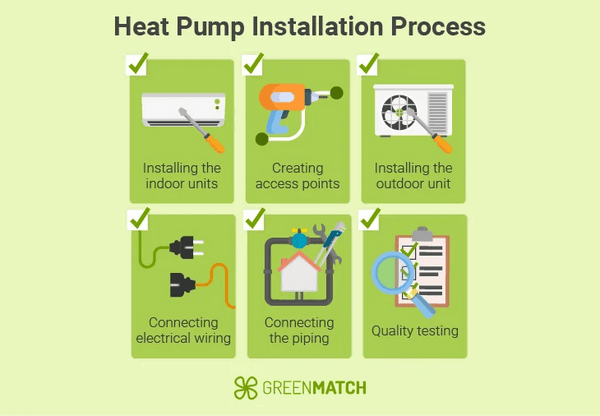
- Installing the indoor units: The contractor starts by setting up the indoor units, which can be wall-mounted, floor-standing, or hidden in the ceiling. These units distribute warm or cool air throughout your home. If you're opting for a mini split heat pump, multiple indoor units may be installed in different rooms to provide targeted temperature control.
- Creating access points: A small hole is drilled in the wall to connect the indoor and outdoor units. This allows for electrical wiring and drain pipes to be installed, keeping the system low-maintenance.
- Installing the outdoor unit: The outdoor unit is mounted outside, usually on the side of the house. In colder areas, it’s positioned above ground to prevent snow from affecting its efficiency.
- Connecting electrical wiring: The electrical wiring is connected between the units, ensuring proper insulation for safety and optimal energy use.
- Connecting the piping: Pipes carrying refrigerant (hot or cold) and drain pipes for condensation are connected between the indoor and outdoor units. These pipes are insulated to improve energy efficiency.
- Quality testing: Before being used, the system is thoroughly tested to ensure it works efficiently and reliably.
Air to air heat pump installation should be handled by professional installers. They can assess your home's suitability, recommend the right setup, and ensure the system is installed with minimal disruption.
Air to air heat pump advantages and disadvantages
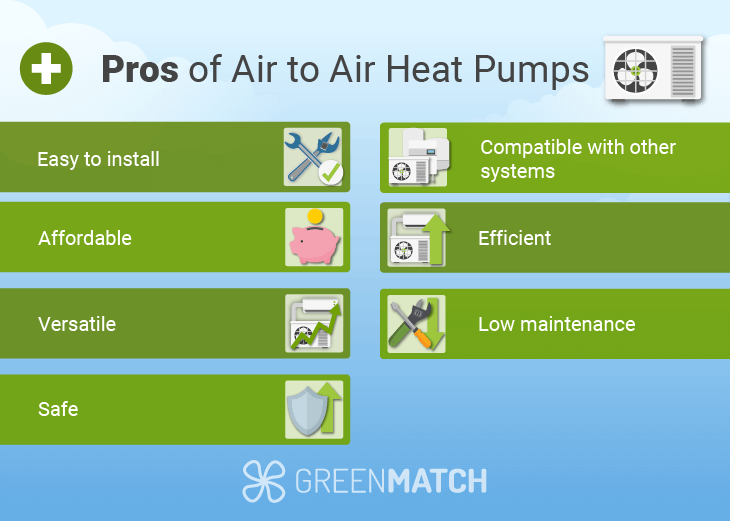
- Easy to install: These types of heat pumps are very easy to install. Only a hole in the wall is needed, and the installation can be done in a single day.
- Compatible with other systems: It can be easily installed in a house with an existing conventional heating system. An air source heat pump and solar panels can also be compatible for optimal sustainability.
- Affordable: An air to air heat pump is affordable and easy to install, making it cheaper than other heating systems since no extra pipework is needed.
- Efficient: Air to air heat pumps are highly energy efficient, producing much more heat than the electricity they consume. For example, with a Coefficient of Performance (CoP) of 4, the heat pump generates 4 times more heat energy than the electricity it uses.
- Versatile: Air to air heat pumps can switch to cooling mode in summer, working as an air conditioner, and provide efficient heating during colder months.
- Low maintenance: Air to air heat pumps require little to no maintenance. Usually, your installer will check the condition of the pump about once a year to ensure optimal performance.
- Safe: Unlike other heating solutions, air to air heat pumps do not bring potentially flammable fuel into the home. This reduces the chances of accidents.
For more advantages, you can read our article where we answer the question: Are air source heat pumps worth it?
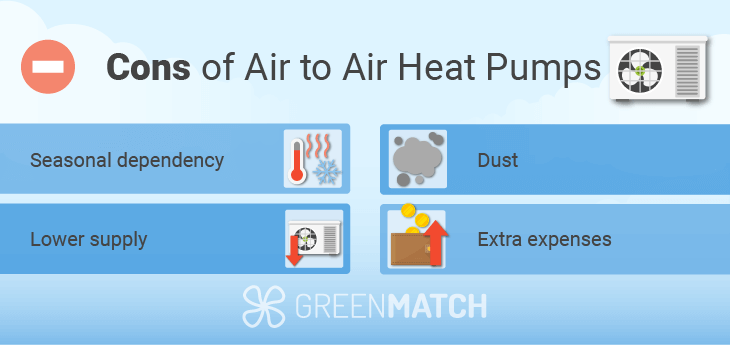
- Seasonal dependency: Are you wondering, "Do heat pumps work in cold weather?" The short answer is yes. However, they are at their most efficient in outdoor temperatures between -3°C and 10°C. When the temperature drops to -10°C or below, the pump's electricity consumption increases. Luckily, UK temperatures don’t usually drop this low.
- Dust: Because fans are used to distribute warm or cool air, the dust contained in the air may move throughout the room, affecting the comfort and cleanliness of your home.
- Lower supply: Air to air heat pumps provide a lower heat supply compared to oil or gas boilers, meaning that you would need bigger vents.
- Extra expenses: If you live in a colder region, you may need to invest in additional components, such as a backup heating source or insulation upgrades. These extra costs are relatively low and often offset by long-term energy savings.
So, before installing an air to air heat pump, take the time to weigh its pros and cons. Pay close attention to its efficiency and performance, especially in colder temperatures, as the system's effectiveness may decrease when temperatures drop below -10°C.
Is an air to air heat pump suitable for my home?
Despite their initial high cost, air to air heat pumps are highly efficient systems that use electricity to heat or cool homes on demand, reducing energy bills and carbon emissions. Their effectiveness is reflected in government initiatives, like nationwide heat pump grants, designed to support the UK’s goal of achieving carbon neutrality by 2050.
However, it is crucial to assess your home's suitability before installing one. This can be done through a specialist evaluation or by using the government's online tool, which considers factors such as your home's age, insulation, glazing, size, and energy performance certificate. Proper assessment ensures the heat pump will be effective for your specific property.
However, if you find yourself asking questions like, "What heat pump size is best for my home?" or "Are heat pumps noisy?" then your best bet is to consult a heat pump installer. They can provide tailored advice and give you the latest figures for supply and installation costs.
Fortunately, you don’t have to look any further for a reliable installer.
We’ve thoroughly vetted several installers across the country and can connect you with up to four of them quickly. Just fill in our 30-second form to request free, no-obligation air source heat pump quotes.
Simply click below to get started now!
- Quotes from local engineers
- Payment by finance available
- Save £7,500 with BUS grant
It only takes 30 seconds



Frequently asked questions
While heat pumps come with a higher upfront cost, they can be a worthwhile investment if you’re replacing an old or inefficient heating system. They can significantly save you money on running costs over time.
Installing an air to air heat pump in 2025 typically costs between £2,400 – £8,800. This includes the price of the heat pump itself and the installation. It’s also crucial to consider the running costs when calculating how much an air to air heat pump will cost you overall.
Air to air heat pumps work by extracting heat from the outside air and using it to warm the inside of a building via fans.
An air to air heat pump derives its name from how it operates. It works by transferring heat from the air outside into your home. If you want to find out more about how air to air heat pumps work, make sure to do some research and consult a heat pump installer.

As a writer with a deep understanding of low-carbon energy systems, Hannah aims to breakdown knowledge barriers and share insights to empower individuals in their pursuit of creating more environmentally conscious homes.

We strive to connect our customers with the right product and supplier. Would you like to be part of GreenMatch?

- Quotes from local engineers
- Payment by finance available
- Save £7,500 with BUS grant
It only takes 30 seconds




